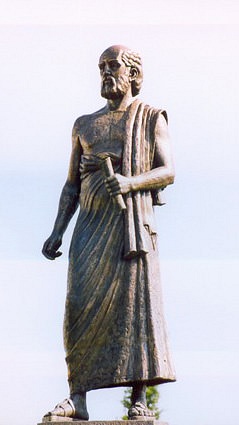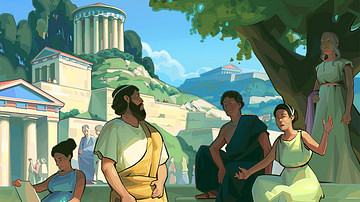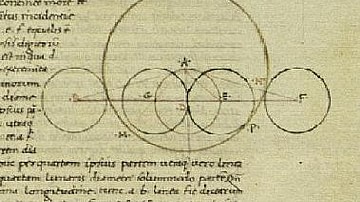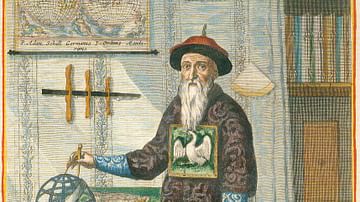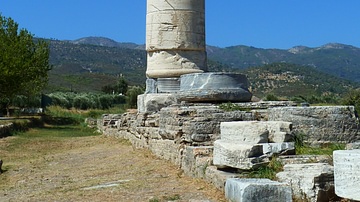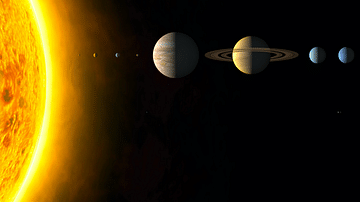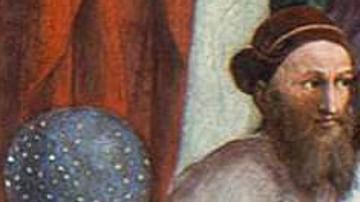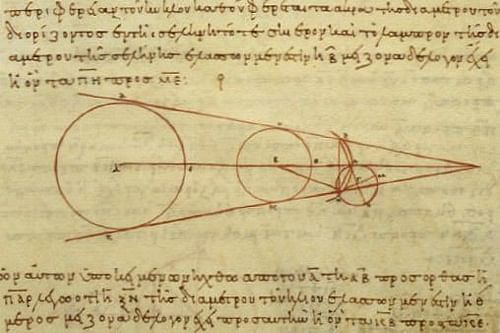
Aristarchus of Samos (l. c. 310 - c. 230 BCE) was a Greek astronomer who first proposed a heliocentric model of the universe in which the sun, not the earth, was at the center. Although his theory was noted by other thinkers of his time, it was rejected as implausible, and the geocentric model was retained for 1,700 years afterward.
Astronomy in ancient Greece developed from the work of the Pre-Socratic Philosophers who advanced a non-theistic view of the universe in their attempt at defining the First Cause of existence. Their inquiries led them to astronomical speculation in trying to determine the nature, and position, of the Earth. At this time, Earth was understood as the center of the universe with the Sun, Moon, and planets revolving around it. Philolaus of Croton (l.c. 470-c. 385 BCE), a Pythagorean philosopher, rejected this model and proposed a Pyrocentric view in which the Earth, and all other planets, revolved around a Central Fire.
Philolaus’ views were rejected, most notably by Aristotle (l. 384-322 BCE), but may have suggested the heliocentric model to Aristarchus. Aristarchus’ works are no longer extant save for his On the Sizes and Distances of the Sun and Moon, but his heliocentric model was preserved by the later mathematician and engineer Archimedes of Syracuse (l. 287-212 BCE) in his work The Sand Reckoner. The model was rejected not because it was considered inadequate in explaining observable phenomena regarding the stars, Sun and Moon, and the planets but, essentially, because it challenged the accepted view of the size of the universe and the Earth’s unique position at its center.
The geocentric model, placing Earth at the center of the universe, was advanced by Hipparchus of Nicea (l. 190-120 BCE), considered the greatest astronomer of his day, and continued in use until it was challenged by the work of Nicolaus Copernicus (l. 1473-1543) and then by others. The heliocentric model was not widely accepted until it was mathematically proven by Sir Isaac Newton (l. 1642-1727) and Aristarchus’ conclusions were validated.
Pre-Socratic Concepts
The Pre-Socratic Philosophers (those who lived before the time of Socrates of Athens, l. 470/469-399 BCE), especially the earliest, focused on defining the First Cause of existence – what was the essential substance from which all else came – without relying on the supernatural explanation provided by Greek religion. Thales of Miletus (l. c. 585 BCE), considered the first Greek philosopher, proposed water as the First Cause while Anaximander (l. c. 610-c. 546 BCE) rejected this, claiming a First Cause could not be defined by any aspect of the observable world. He suggested a creative force – the apeiron – as the beginning of all things while his student Anaximenes (l. c. 546 BCE) disagreed and claimed air as First Cause since, among his other claims, it sustained life.
The works of all the Pre-Socratic philosophers, to greater or lesser degrees, have been lost and only exist in fragments preserved by later writers but it seems these early thinkers moved from examination of terrestrial phenomena to celestial considerations in their inquiries into the origin of the universe. Thales is noted for having accurately predicted the solar eclipse of 28 May 585 BCE and those who came after him, sometimes referred to as “natural philosophers” because of their interest in the nature of things, became what one would recognize today as astronomers.
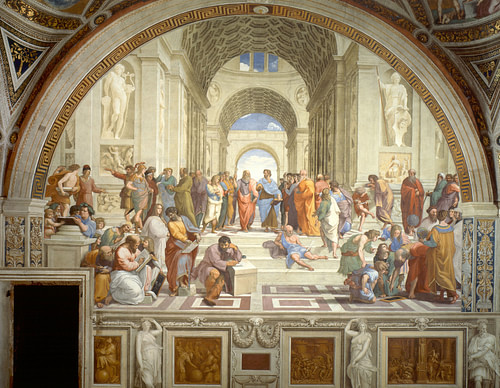
The suggestions of the earliest philosophers were rejected by Pythagoras (l. c. 571 - c. 497 BCE) as either too simple or, in Anaximander’s case, speculative, who claimed Number as the First Cause. This was a dramatic shift in that it elevated mathematics, already a respected discipline, to a higher level as the means by which one apprehended Truth. Numbers had neither beginning nor end, suggesting an eternal aspect, while also defining the observable world, differentiating One from Many and, Pythagoras realized, also informed music in that musical notes expressed mathematical concepts which produced harmonies and encouraged balance. Number, and its expression through music, was harmony itself and, in Pythagorean thought, kept the universe intact.
Philolaus & Archytas
Pythagoras wrote nothing down and only communicated his beliefs to an inner circle of followers who were sworn to secrecy. Only initiates, therefore, knew his teachings until Philolaus, considered by some as his successor, wrote them down in either one or three books. Philolaus’ works are also lost, existing only in fragments cited by later writers, and it is difficult to separate his original thoughts, for the most part, from those of Pythagoras but he seems to have developed the Pythagorean concept of music-as-mathematics and applied it to his study of the universe. He maintained Pythagoras’ claim for Number as the First Cause and for One as the origin of the Many and concluded that the universe came from, and was sustained by, a Celestial Fire at its center around which the Earth, Sun, Moon, planets, and stars revolved. As noted, prior to this, the Earth was considered the center of the universe with all other spheres revolving around it.
One of Philolaus’ students, the astronomer and statesman Archytas of Tarentum (l. c. 435 - c. 360 BCE) seems to have advanced Philolaus’ model, inventing the discipline of mathematical mechanics to accurately explain the motion of the planets and their position relative to each other (later developed and usually attributed to Aristotle and known today as Aristotelian Mechanics). Archytas, also a Pythagorean, was the teacher of Eudoxus of Cnidus (l. c. 410 - c. 347 BCE) who also studied under Plato (l. 428/427-348/347 BCE). Plato maintained the geocentric model of the universe and Eudoxus seems to have rejected Archytas’ view and developed Plato’s in which the planets moved on tracks in a circular motion around the Earth.
Eudoxus claimed there was no random aspect to planetary motion, as each was set on its own track, but that the spheres only seemed to move randomly as they slid forward, and sometimes back, on their tracks. Although he supported Plato’s vision, one of Archytas’ surviving fragments on the importance of individual pursuit of knowledge may have influenced both his work and that of Aristarchus:
In subjects of which one has no knowledge, one must obtain knowledge either by learning from someone else, or by discovering it for oneself. That which is learnt, therefore, comes from another and by outside help; that which is discovered comes by one’s own efforts and independently. To discover without seeking is difficult and rare, but if one seeks, it is frequent and easy; if, however, one does not know how to seek, discovery is impossible. (Freeman, 80, fragment 3)
Eudoxus knew how to seek based on the teachings of Archytas and Plato, creating the Eudoxan Model of the universe with an unmovable Earth at its center. It was this model that Aristarchus of Samos challenged when he began his own independent inquiry into the subject.
Aristarchus’ Model
How much of the Pre-Socratic material was available to Aristarchus is unknown but he was also a Pythagorean and, most likely, had access to Philolaus’ works or at least may have heard of his theory. Philolaus may not have influenced him at all, however, as the geocentric model presented a problem to the Greek astronomers which many, including Aristotle, tried to solve: why, if the Earth was stationary and the planets revolved regularly around it, did these planets appear sometimes larger and brighter than at other times?
Aristarchus’ extant work, On the Sizes and Distances of the Sun and Moon, maintains the geocentric view, probably (as suggested by scholar Thomas Heath) because he had not yet conceived of the heliocentric model. Aristarchus understood that the Moon casts no light but shines by reflection of the Sun’s light and so claimed that if one measured the angle between the Sun and Moon when the Moon is half-illuminated (said angle suggested by the illumination itself), one could calculate their distances.
He determined the angle at 87 degrees, remarkably close to the actual angle understood today as 89 degrees, and his further calculations determined the Sun was 20 times further away from the Earth than the Moon (it is actually 400 times further away). How this work may have influenced his (supposedly) later model of the heliocentric universe is unknown but it is possible that, through his inquiries into the distance of the Sun and Moon from the Earth, it made more sense to him that the Sun was at the center of all the other planets.
As noted, Aristarchus’ model is only preserved in a passage from Archimedes’ The Sand Reckoner. Archimedes wanted to know how many grains of sand would fill the universe and, to calculate this, needed to know how large the universe was. In relating his calculations, he mentions Aristarchus who believed the universe to be much larger than was generally accepted by Archimedes’ contemporaries:
You, King Gelon, are aware the 'universe' is the name given by most astronomers to the sphere whose center is the center of the Earth and whose radius is equal to the straight line between the center of the Sun and the center of the Earth. This is the common account as you have heard from astronomers. But Aristarchus has brought out a book consisting of certain hypotheses, wherein it appears, as a consequence of the assumptions made, that the universe is many times greater than the 'universe' just mentioned. His hypotheses are that the fixed stars and the Sun remain unmoved, that the Earth revolves about the Sun on the circumference of a circle, the Sun lying in the middle of the orbit, and that the sphere of fixed stars, situated about the same center as the Sun, is so great that the circle in which he supposes the Earth to revolve bears such a proportion to the distance of the fixed stars as the center of the sphere bears to its surface. (1-2)
Aristarchus may have arrived at these conclusions through the calculations he made in his earlier work but it is possible it was suggested by Philolaus’ vision in which the Central Fire sat at the center of the universe and ten planets revolved around it (as Philolaus conceived of the Moon, Sun, and fixed stars as “planets”) in the following order: counter-earth (which is never explained or defined), Earth, the Moon, the Sun, Mercury, Venus, Mars, Jupiter, Saturn, and the Fixed Stars. Whether Aristarchus’ view conformed to Philolaus’ is unknown but, according to the Archimedes’ passage, the position of the Fixed Stars matches the position in the earlier philosopher’s model.
Rejection of the Model
A passage in Plutarch (l. c. 45/50 – c. 120/125 CE) also suggests that Aristarchus may have been acquainted with Philolaus’ work in that it references the “Hearth” which is another term used by Philolaus for the Central Fire. It is also possible, however, that the “Hearth” in Plutarch’s work refers to the Earth – the center of the universe as the hearth was to the home - being “disturbed” by Aristarchus’ model but, either way, the passage suggests the negative reaction generated by Aristarchus’ model. Plutarch notes how the philosopher Cleanthes of Assos wanted Aristarchus charged with impiety for suggesting the Earth was not the center of the universe.
In Plutarch’s Concerning the Face Which Appears in the Orb of the Moon, in which the characters discuss aspects of astronomy, one Lucius says:
Oh, sir, just don’t bring suit against us for impiety as Cleanthes thought that the Greeks ought to lay an action for impiety against Aristarchus the Samian on the ground that he was disturbing the Hearth of the universe because he sought to save the phenomena by assuming that the heaven is at rest while the Earth is revolving along the ecliptic and, at the same time, is rotating on its own axis. (6.1.35)
Cleanthes (l. c. 330 - c. 230 BCE) was a prominent stoic philosopher in Athens who, according to Diogenes Laertius (l. c. 180-240 CE), accused Aristarchus of impiety for his new model of the universe which displaced Earth. The gods were thought to live on the Earth, after all, and to suggest that Earth was the same as any other planet in the solar system challenged that concept, even among those who may not have literally believed in it. Cleanthes also seems to have objected to Aristarchus defining the Sun as a stationary star around which the planets revolved which devalued its former status as a divine source of light and life which revolved around Earth.
Whether Cleanthes ever made this charge is unclear as, first, Diogenes Laertius is often unreliable and, second, it is possible that Aristarchus was the one who brought Cleanthes up on charges. Plutarch’s use of Cleanthes’ accusation against Aristarchus, however, suggests this is how their altercation was understood in his time and seems also in keeping with how such a claim would have been received. Philolaus’ claim that the universe was Pyrocentric was dismissed by Aristotle, considered the authority on the subject, and so, most likely, was Aristarchus’ model although there are no extant works to support that claim. There exists, in fact, no mention of the model at all outside of Archimedes’ passage until Plutarch’s time.
Conclusion
According to Plutarch, the astronomer Seleucus of Seleucia (l. c. 190 - c. 150 BCE) proved Aristarchus’ model but there is no record of this from Seleucus’ time and Plutarch does not provide details. Seleucus was a contemporary of Hipparchus of Nicea who rejected Aristarchus’ model but, again, no extant writings provide details of this rejection. It is understood that Hipparchus rejected Aristarchus’ claims because they ran counter to the prevailing understanding of the size of the universe and the trajectories of the planets, which were understood as perfect circles.
The geocentric model was codified by the astronomer Claudius Ptolemy (l. 100-170 CE) in his Almagest and was accepted as accurate until 1543 when Copernicus’ On the Revolution of the Celestial Spheres was published arguing for heliocentrism and, in an early draft, cited both Philolaus and Aristarchus. The Church opposed the heliocentric model as it contradicted scripture which maintained Earth as the center of God’s creation. This opposition was supported by the early activists of the Protestant Reformation, most notably Martin Luther (l. 1483-1546) and Philip Melanchthon (l. 1497-1560) who dismissed Copernicus’ claims as heretical nonsense.
The astronomer Tycho Brahe (l. 1546-1601) tried to synthesize the Copernican and Ptolemaic systems and his work was continued by Johannes Kepler (l. 1571-1630) who established the laws of planetary motion. Their work provided the foundation for Sir Isaac Newton’s mathematical proofs of the heliocentric universe first proposed almost 2,000 years earlier by Aristarchus. In the present day, he is widely respected by the scientific community, evidenced in a number of ways, including naming the powerful telescope Aristarchos at the National Observatory in Athens, Greece in his honor.
